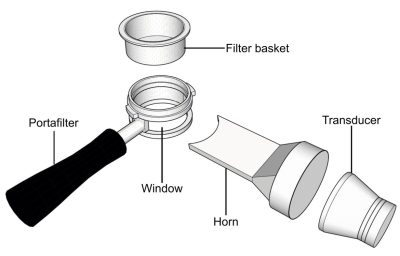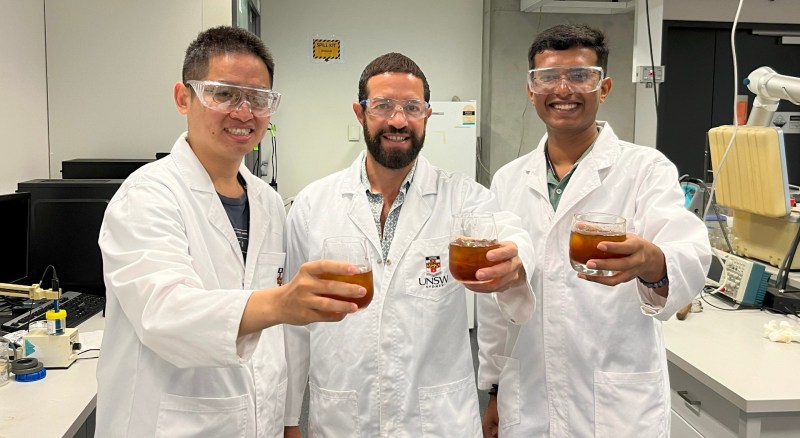Some coffee snobs might call this sacrilege. Cold brew is supposed to take a long time — that’s part of how it gets its characteristic smoothness. But a group of engineers from the University of New South Wales (UNSW Sydney) have figured out a way to cut the time down from several hours to a mere three minutes, using ultrasonic waves.
 Typically, the cold brew coffee process takes between 12 and 24 hours. Enough time to steep the grounds and extract the flavors without the benefit of hot water. This is how it differs from iced coffee, which is brewed hot and poured over ice.
Typically, the cold brew coffee process takes between 12 and 24 hours. Enough time to steep the grounds and extract the flavors without the benefit of hot water. This is how it differs from iced coffee, which is brewed hot and poured over ice.
Interestingly, the UNSW Sydney engineers’ process uses a typical prosumer-grade espresso machine and involves blasting the portafilter with a transducer and a horn. This transforms the coffee basket into a sonoreactor. Sound waves at a frequency of 38.8 kHz are injected at multiple points through the walls, generating acoustic cavitation within. You can read all about it in Ultrasonics Sonochemistry.
That’s not even the most exciting part. The study found that this arrangement is capable of doubling both the extraction yield and caffeine concentration, compared with non-soundblasted samples. The team sent samples of the coffee off to be evaluated on aroma, texture, flavor, and aftertaste. Although the one-minute extraction samples received similar ratings to a 24-hour brew in terms of flavor and aftertaste, they lacked the intensity and dark chocolate aroma of the longer brew. But the three-minute extraction samples scored quite highly in all areas, suggesting that the average cold brew drinker wouldn’t be able to tell the difference.
Would you like to roast your own beans at home? You can use a popcorn popper, but you might get tired of semi-uneven roasts and upgrade to a DIY wobble disk roaster.

















I wonder if you could put a mason jar of coffee and ice water in an ultrasonic cleaner and get any results? May have to do some experiments!
Quite similar to my thoughts.
I’d just put normal water and ground coffee into an ultrasonic cleaner (which has never been used with anything but (distilled) water) and pour that into a French press.
Good idea!
I’m going to try a thin steel can, rather than glass: maybe better coupling, certainly less mass.
Mason jars actually work fairly well in ultrasonic cleaners, I use Mason jars in water to clean small parts with flammable solvents I don’t feel safe filling the reservoir with
Might have more losses. You can make many glasses ring like a bell where a can would not.
So, anybody have joy with doing this? I bought a cheap-o ultrasonic cleaner (been on the fence on getting one for a while, this article pushed me off the fence). No joy for me: roughly 2c water, 1/4c grounds in a mason jar; 5 minutes “clean”. ‘course the paper/article is specialized hardware.
No joy. Just dumped colde water and ground coffee into the stainless steel tub of my ultrasonic cleaner, turned it on for about 4 minutes and watched the surface migrate and writh, and then ran it through an airpress.
It tasted okay, but was weak, and pale.
“doubling … caffeine concentration”
That’s a win in my book!
Makes me want to buy a Flair and some ultrasonic transducers and play around.
Line a #2 Melita filter cone with transducers, one cup with half the grounds. Might need to make the exit hole smaller so what’s there soaks longer.
De’Longhi had this feature for a while now
https://www.youtube.com/watch?v=0qJ5phSR2rA
When you have cavitation bubbles and they collapse, doesn’t the temperature inside actually go up well beyond boiling?
So the coffee is boiling, but in very focused points and then instantly cools back down.
Ok, so modify a vacuum chamber (another proven accelerator of cold brew, although not THAT fast) with ultrasonic transducers give it 2 minutes so my burrito and cold brew are finished at the same time. Then we’ll have a winner.
Layargaming When cavitation bubbles burst, doesn’t the internal temperature rise to a point considerably over boiling?
Thus, the coffee boils only in concentrated areas before rapidly cooling again.
That was my thought also. Is this really cold brewing? Did the study compare the taste of the product to actual cold brewed coffee?
Did you consider reading the article?
“The team sent samples of the coffee off to be evaluated on aroma, texture, flavor, and aftertaste. Although the one-minute extraction samples received similar ratings to a 24-hour brew in terms of flavor and aftertaste, they lacked the intensity and dark chocolate aroma of the longer brew. But the three-minute extraction samples scored quite highly in all areas, suggesting that the average cold brew drinker wouldn’t be able to tell the difference.”
WTF is wrong with you FA reader?
The mods have zero tolerance for such behavior.
“sonic brew”? Sounds like a good idea!
so that is why The Hedgehog is so fast!
IIRC he’s in an old folks home.
They dropped all charges as his noodle is cooked from decades of cocaine/vodka.
You’re mistaking the hedgehog for the guy in the White House.
B^)
Brewing is the extracting of some very tasty compounds and some not so tasty that are water soluable or water transported. I suppose there are other liquids, but water seems to be universal. All these extraction processes require time for the solvent of choice to remove and transport depending surface area and time to dissolve. You technically can extract from a whole roasted bean, but I ain’t going to wait that long. Espresso does it hot at high pressure, cold brewing does it slow at ambient or even refrigerated. Ultra sonic would accelerate the process, ultarsonic hot would be even faster, ultrasonic espresso would be even faster still.
Pic show _lame_ translucent ‘coffee’.
Why would I take advice from people who drink slightly colored water as coffee?
Can’t they find someone who likes coffee?
These fools might as well be drinking a charbucks milkshake.
I’m sure some of the the hoightiest of toights among coffee snobs would disagree that all coffee is black as charcoal. In fact some of the stuff that snobs think I should like is very light roasts which make fairly clear and light colored drinks if done properly especially if diluted with ice. And you tend to see proponents of lighter roasts with espresso…
I’ve never heard of blond coffee being over extracted with steam (espresso). Much espresso blend contains some robusta (spit).
People that like blond roast coffee don’t like coffee.
Frog press of the win. Not French/Italian roast though.
If you ever have the chance, try a Belgian roast. It’s completely different. Different roasting, different taste, different smell.
I came up with the concept of ultrasonic coffee years ago. I didn’t make it since I’m not really a coffee nut and can get coffee for free at work. I’m curious what it tastes like.